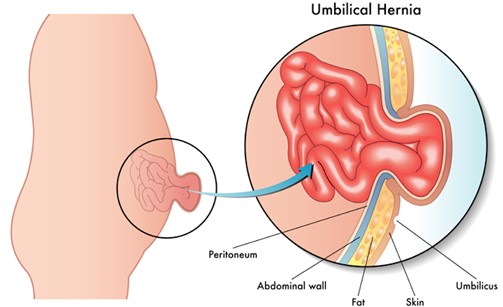A mother brings her 4-month-old son to the clinic with a quarter taped over his umbilicus, and tells the nurse the quarter is supposed to fix her child's hernia. Which explanation should the nurse provide?
An abdominal binder can be worn daily to reduce the protrusion.
This hernia is a normal variation that resolves without treatment.
The quarter should be secured with an elastic bandage wrap.
Restrictive clothing will be adequate to help the hernia go away.
The Correct Answer is B
Choice A: An abdominal binder can be worn daily to reduce the protrusion is not a correct explanation for the nurse to provide, as this is not an effective or recommended method to treat a hernia. This is a distractor choice.
Choice B: This hernia is a normal variation that resolves without treatment is a correct explanation for the nurse to provide, as this refers to an umbilical hernia, which is a common and harmless condition in infants that usually disappears by age 2. Therefore, this is the correct choice.
Choice C: The quarter should be secured with an elastic bandage wrap is not a correct explanation for the nurse to provide, as this is a folk remedy that has no scientific basis and can cause skin irritation and infection. This is another distractor choice.
Choice D: Restrictive clothing will be adequate to help the hernia go away is not a correct explanation for the nurse to provide, as this is not a proven or safe way to treat a hernia. This is another distractor choice.

Nursing Test Bank
Naxlex Comprehensive Predictor Exams
Related Questions
Correct Answer is C
Explanation
Choice A: Think about reasons the episodes occur. This is not the best instruction, as it may increase the anxiety level of the client. Thinking about reasons may trigger negative thoughts, emotions, or memories that can worsen the anxiety. The nurse should teach the client to focus on coping skills rather than causes.
Choice B: Center attention on positive upbeat music. This is not the best instruction, as it may not be effective for all clients. Listening to positive upbeat music may help distract or soothe some clients, but it may also irritate or annoy others. The nurse should teach the client to choose music that matches their mood and preference.
Choice C: Practice using muscle relaxation techniques. This is the best instruction, as it can reduce the physical symptoms of anxiety. Muscle relaxation techniques involve tensing and relaxing different muscle groups in a systematic way, which can lower blood pressure, heart rate, and breathing rate. The nurse should teach the client how to perform muscle relaxation techniques and practice them regularly.
Choice D: Find outlets for more social interaction. This is not the best instruction, as it may not be feasible or helpful for all clients. Finding outlets for more social interaction may help some clients feel supported or connected, but it may also stress or overwhelm others. The nurse should teach the client to seek social support that is appropriate and comfortable for them.
Correct Answer is C
Explanation
Choice C is correct because repositioning the infant every 2 hours can help expose different parts of the skin to the phototherapy light and increase the effectiveness of the treatment. The nurse should also check the skin for signs of irritation or burns.
Choice A is incorrect because feeding the infant every 4 hours is not specific to home phototherapy. The infant may need more frequent feedings depending on their hunger cues and weight gain.
Choice B is incorrect because performing diaper changes under the light is not necessary and may expose the infant's genitals to excessive light and heat. The nurse should advise the parents to cover the infant's eyes and genitals with protective shields during phototherapy.
Choice D is incorrect because covering the infant with a receiving blanket can reduce the exposure of the skin to the phototherapy light and decrease the effectiveness of the treatment. The nurse should advise the parents to keep the infant unclothed or only in a diaper during phototherapy.
Whether you are a student looking to ace your exams or a practicing nurse seeking to enhance your expertise , our nursing education contents will empower you with the confidence and competence to make a difference in the lives of patients and become a respected leader in the healthcare field.
Visit Naxlex, invest in your future and unlock endless possibilities with our unparalleled nursing education contents today
Report Wrong Answer on the Current Question
Do you disagree with the answer? If yes, what is your expected answer? Explain.
Kindly be descriptive with the issue you are facing.
